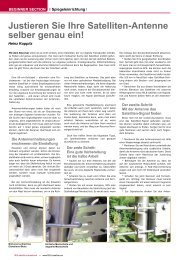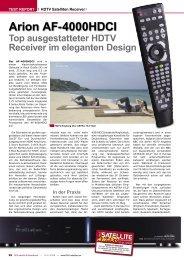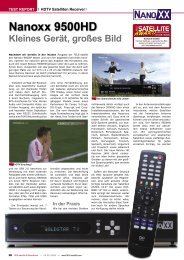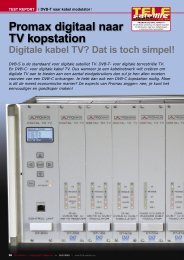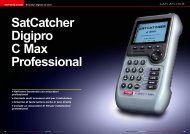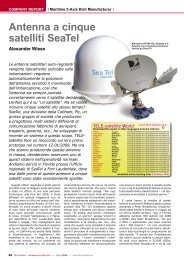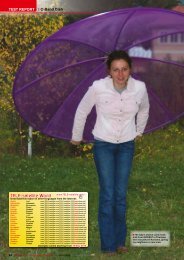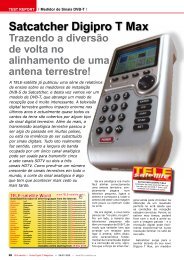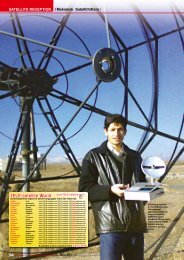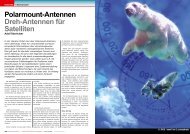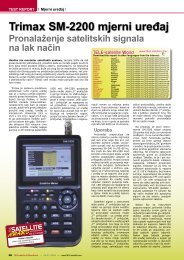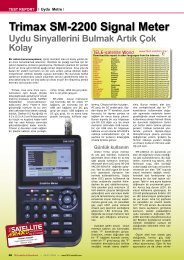SatCatcher Digipro C Max Professional
SatCatcher Digipro C Max Professional
SatCatcher Digipro C Max Professional
You also want an ePaper? Increase the reach of your titles
YUMPU automatically turns print PDFs into web optimized ePapers that Google loves.
TEST REPORT Digital Cable Meter<br />
<strong>SatCatcher</strong><br />
<strong>Digipro</strong><br />
C <strong>Max</strong><br />
<strong>Professional</strong><br />
• compares favorable to professional meters<br />
• comes with many useful accessories for the<br />
installer<br />
• easy to read screen even in direct sunlight<br />
• includes Tilt measurement for professional<br />
installations<br />
TELE-satellite Magazine<br />
Business Voucher<br />
www.TELE-satellite.info/12/03/satcatcher<br />
Direct Contact to Sales Manager<br />
34 TELE-satellite International — The World‘s Largest Digital TV Trade Magazine — 02-03/2012 — www.TELE-satellite.com www.TELE-satellite.com — 02-03/2012 — TELE-satellite International — The World‘s Largest Digital TV Trade Magazine 35
TEST REPORT Digital Cable Meter<br />
An Accurate Instrument<br />
With Many Accessories<br />
Accuracy is something<br />
that every installer will<br />
value with a signal meter<br />
but apart from that true<br />
professional users have<br />
further demands on a meter:<br />
the instrument should<br />
have a bright and readable<br />
display, and its keyboard<br />
should be easy to oper-<br />
ate. It should also offer a<br />
wide choice of accessories<br />
making the work simpler<br />
and more efficient. To our<br />
delight, the new <strong>Digipro</strong> C<br />
<strong>Max</strong> by Satcatcher fulfills<br />
all those requirements.<br />
Its display is exceptionally<br />
bright and clear, you can<br />
operate its keyboard even<br />
with gloves on your hands,<br />
and the number of accessories<br />
they offer to the professional<br />
user is really surprising.<br />
The meter can be supplied<br />
packaged in two ways.<br />
In a metal box like other<br />
Satcatcher meters or in a<br />
premium package with lots<br />
of extras included. For our<br />
test we opted for the latter<br />
and were delighted at the<br />
many useful accessories.<br />
The most unusual and most<br />
useful for an installer is a<br />
fully adjustable vest with a<br />
lot of pockets and straps.<br />
It allows you not only to<br />
transport and use the meter<br />
in a convenient way but<br />
also to keep handy all sorts<br />
of other tools an installer<br />
must have. Apart for the<br />
vest, you get a plug type<br />
power supply, a car lighter<br />
DC charger, a neck strap<br />
with a piece of sheep skin<br />
fur to avoid skin irritation,<br />
and a bad weather cover<br />
for the meter along with<br />
an attachable sun shade.<br />
Everything is neatly packed<br />
in a carrying bag so you<br />
do not need to worry that<br />
your meter accessories will<br />
disappear somewhere over<br />
time.<br />
The workmanship of the<br />
<strong>Digipro</strong> C <strong>Max</strong> is very good.<br />
The enclosure is robust but<br />
quite elegant at the same<br />
36 TELE-satellite International — The World‘s Largest Digital TV Trade Magazine — 02-03/2012 — www.TELE-satellite.com<br />
02-03/2012<br />
Satcatcher <strong>Digipro</strong> C <strong>Max</strong><br />
More than a cable meter: includes<br />
everything a professional installer needs<br />
time. Buttons are large<br />
and clearly labeled. The<br />
POWER button has an edging<br />
around it what guarantees<br />
that the meter will<br />
not switch on accidentally<br />
when pressed against a<br />
solid surface. The keyboard<br />
consists of a numeric keypad,<br />
quick access buttons,<br />
navigational arrows and 4<br />
function keys F1 - F4. The<br />
function of these F1 – F4<br />
buttons depends on the<br />
particular menu or screen<br />
you arrived at and is always<br />
explained at the bottom of<br />
the display window. Speaking<br />
of the display, it is one<br />
of the strongest points of<br />
this meter. This TFT LCD It<br />
is very bright and clear. You<br />
will be able to read it even<br />
outside in a very sunny day.<br />
There is also a loudspeaker<br />
embedded in the <strong>Digipro</strong> C<br />
<strong>Max</strong> <strong>Professional</strong>, giving off<br />
a significant sound volume.<br />
The <strong>Digipro</strong> C-<strong>Max</strong> <strong>Professional</strong><br />
lets you either use<br />
a pre-programmed channel<br />
band plan or you may<br />
choose to blindscan the<br />
whole bandwidth. The effort<br />
you put into the initial channel<br />
band plan programming<br />
will pay off in much quicker<br />
measurements. To create<br />
a band plan, you enter the<br />
Meter Config menu and select<br />
Edit Channel item. In<br />
this screen, you edit the<br />
channel name (most of the<br />
installers would probably<br />
use the standard channel<br />
designators like: S02,<br />
S28, K32), its kind (analog<br />
or digital), and a number<br />
of parameters as: frequencies,<br />
modulation, symbol<br />
rate, bandwidth. Of course<br />
there is a different set of
Table 1. Digital TV signal measurement results<br />
Power [dBµV] MER [dB]<br />
Signal C-<strong>Max</strong> Ref C-<strong>Max</strong> Ref<br />
256QAM 474 MHz 87,1 87,7 38,8 36,7<br />
64QAM 474 MHz 87,1 87,7 37,9 36,8<br />
256QAM 674 MHz 82,5 83 39,4 35,6<br />
64QAM 674 MHz 82,6 82,8 38,7 35,4<br />
parameters for analog and<br />
for digital channel. In this<br />
way, you edit channel by<br />
channel and save them in<br />
the meter’s memory. Such<br />
a list of the channels that<br />
are present in a given cable<br />
network is called a band<br />
plan of this network. Once<br />
you have created a correct<br />
band plan for the cable<br />
systems you are about<br />
to install and measure, you<br />
can enter the Auto Measure<br />
menu item and make<br />
the meter measure every<br />
channel form the list one<br />
by one.<br />
However, it is also possible<br />
to scan an unknown<br />
network. In such case, the<br />
<strong>Digipro</strong> C-<strong>Max</strong> does a smart<br />
thing: it recognizes fully<br />
automatically all analog<br />
channels as well as the QAM<br />
modes and symbolrates for<br />
the digital DVB-C channels.<br />
For analog TV channels it<br />
shows the video and audio<br />
frequencies along with their<br />
signal levels and S/N ratio.<br />
The measurement results<br />
screen for a DVB-C signal<br />
is naturally more complex.<br />
You get not only signal frequency,<br />
QAM order, symbol<br />
rate, channel power,<br />
modulation error ratio<br />
(MER) and carrier-to-noise<br />
(C/N) readings but also a<br />
graphic representation of<br />
the constellation diagram.<br />
By pressing a button you<br />
can enlarge the diagram.<br />
This is perfect to asses the<br />
signal quality visually: the<br />
tighter the green dots’ concentration<br />
in the center of<br />
the squares, the less noisy<br />
the signal is. Of course,<br />
visual assessment is rather<br />
subjective and not very accurate,<br />
therefore there are<br />
MER and C/N readings that<br />
correspond to the quality of<br />
the digital signal.<br />
Furthermore, the <strong>Digipro</strong><br />
C-<strong>Max</strong> offers a spectrum<br />
view. It produces a clean<br />
picture of the frequency<br />
spectrum with adjustable<br />
span and amplitude. You<br />
can set the following frequency<br />
spans: FULL, 500,<br />
200, 100, 50, 32, 16, and 8<br />
MHz. <strong>Max</strong>imum amplitude<br />
can be set from 60 to 120<br />
dBµV in 10 dBµV steps. <strong>Digipro</strong><br />
C-<strong>Max</strong> creates a very<br />
readable spectrum picture.<br />
It does not take long to<br />
scan the whole bandwidth.<br />
Even the best looking<br />
meter, and <strong>Digipro</strong> C-<strong>Max</strong><br />
looks great indeed, would<br />
not be worth its price if its<br />
measurement results were<br />
improbable. Therefore, we<br />
compared the results produced<br />
by the <strong>Digipro</strong> C-<strong>Max</strong><br />
with another high class reference<br />
meter. We are delighted<br />
to announce that<br />
the results were in perfect<br />
agreement. Please examine<br />
Table 1 and Table 2.<br />
Both for digital and analog<br />
TV signals, the channel<br />
power results were practically<br />
identical. Also the<br />
MER measurements were<br />
matching one another very<br />
well indeed. The only differences<br />
we noted in the S/N<br />
measurements, this, however,<br />
is common between<br />
different meter brands.<br />
That’s because S/N measurements<br />
depend on the<br />
particular frequency a me-<br />
Table 2. Analog TV signal measurement results<br />
Power [dBµV] S/N [dB]<br />
Signal C-<strong>Max</strong> Ref C-<strong>Max</strong> Ref<br />
Video 471,25 MHz 61,3 64,4 23,7 48,6<br />
Audio 477,75 MHz 50,4 52<br />
Video 576,25 MHz 64 63,7 26,1 17,7<br />
Audio 581,75 MHz 50,3 49,8<br />
ter takes as a noise reference<br />
level. As a result, S/N<br />
and C/N can be compared<br />
only if measured with the<br />
same meter model but not<br />
when measured with different<br />
models and makes.<br />
MER is a much better signal<br />
quality indicator as this<br />
value can be measured with<br />
different meters and you<br />
can expect similar results<br />
with any product. Our general<br />
conclusion: <strong>Digipro</strong> C-<br />
<strong>Max</strong> is a very accurate meter<br />
and you can fully rely on<br />
its signal strength and MER<br />
measurements.<br />
A great highlight is another<br />
positive feature: the<br />
<strong>Digipro</strong> C-<strong>Max</strong> not only<br />
takes measurements but it<br />
can also play back digital<br />
channel video and audio.<br />
Once it locks to the signal,<br />
it searches the NIT table<br />
inside the transport stream<br />
and based on the informations<br />
found there, the meter<br />
displays a list of TV and<br />
radio channels. The last remaining<br />
step is to select the<br />
channel you want to watch<br />
and press a button. Of<br />
course, this works only for<br />
FTA channels as the meter<br />
does not have any CI slot<br />
or smart card reader and<br />
can not descramble PayTV<br />
channels. The <strong>Digipro</strong> C-<br />
<strong>Max</strong> does not display analog<br />
TV channels either but taking<br />
into account how fast<br />
the technology advances,<br />
analog channels will disappear<br />
from CATV networks<br />
anyway quite soon. So this<br />
is not something to care<br />
about.<br />
Finally we come to a truel-<br />
■<br />
TELE-satellite expert Jacek<br />
Pawlowski wears the installer's<br />
vest from Satcatcher. The vest<br />
offers multiple pockets for the<br />
installer - and even matches the<br />
<strong>Digipro</strong> C-<strong>Max</strong> protective case'<br />
color!<br />
38 TELE-satellite International — The World‘s Largest Digital TV Trade Magazine — 02-03/2012 — www.TELE-satellite.com www.TELE-satellite.com — 02-03/2012 — TELE-satellite International — The World‘s Largest Digital TV Trade Magazine 39
1 2 3<br />
40 TELE-satellite International — The World‘s Largest Digital TV Trade Magazine — 02-03/2012 — www.TELE-satellite.com www.TELE-satellite.com — 02-03/2012 — TELE-satellite International — The World‘s Largest Digital TV Trade Magazine 41<br />
4<br />
5<br />
6<br />
7<br />
8<br />
9<br />
10<br />
11<br />
12<br />
13<br />
14<br />
15<br />
16<br />
17<br />
18<br />
19<br />
1. Main menu<br />
2. Channel measure<br />
3. Tilt measurement screen<br />
4. DVB-C signal shown in spectrum view<br />
5. Configuration menu<br />
6. Band plans<br />
7. One of the preprogrammed and plans<br />
8. Editing a channel in a band plan<br />
9. Options menu<br />
10. Identifying digital TV signal chosen in<br />
the spectrum view<br />
11. 256QAM constellation and signal<br />
measurement results<br />
12. Closer examination of the constellation<br />
allows you to visually asses signal quality<br />
13. Meter searches NIT in DVB-C signal to<br />
create a channel list<br />
14. Channel list of the selected DVB-C<br />
carrier<br />
15. Meter displays channel video like a small<br />
TV-set<br />
16. A mix of analog and digital TV signal in a<br />
real cable network<br />
17. Analog TV signals<br />
18. Digital TV signals<br />
19. Detecting the parameters of digital<br />
carrier
ly valuable function of the<br />
meter, which is so useful<br />
for the professional installer:<br />
the tilt measurement.<br />
Up to ten channels can be<br />
selected for this. Usually,<br />
you would select channels<br />
evenly distributed over the<br />
whole frequency range. Of<br />
course, the selected channels<br />
must carry a TV signal.<br />
You first measure those<br />
channels in the TILT Measure<br />
submenu somewhere in<br />
the beginning of the cable<br />
network, where all the signals<br />
are strong and relatively<br />
equal in amplitude.<br />
then you press the REF button<br />
to store those channels’<br />
levels as reference. Then<br />
you move to various other<br />
points of the network and<br />
repeat this measurement.<br />
You will see the difference<br />
expressed in decibels between<br />
the reference level<br />
and the current level for<br />
every channel.<br />
The tilt measurement allows<br />
you to quickly identify<br />
signal level differences<br />
over a specified frequency<br />
range. Then all you do is<br />
insert an attenuator or<br />
an equalizar in order to<br />
smoothen the differences<br />
according to the cable<br />
system’s specifications.<br />
Thanks to this, you can<br />
easily find out if the cabling<br />
along with the distribution<br />
equipment does not introduce<br />
excessive attenuation<br />
in particular parts of the<br />
cable TV frequency range.<br />
We found the <strong>Digipro</strong> C-<br />
<strong>Max</strong> to be a very mature<br />
meter, offering to the in-<br />
+<br />
–<br />
TECHNICAL<br />
DATA<br />
Manufacturer <strong>SatCatcher</strong> Ltd, Unit 7, Salvesen Way, Hull,<br />
East Yorkshire, HU3 4UQ, UNITED KINGDOM<br />
Webpage www.satcatcher.com<br />
E-mail sales@satcatcher.com<br />
Tel +44-1652-408191<br />
Model <strong>Digipro</strong> C <strong>Max</strong><br />
Function Digital and analog cable TV meter<br />
Input frequency range 46 MHz - 862 MHz for digital TV<br />
46 MHz – 870 MHz for analog TV<br />
Input signal level range 40dBuV - 110dBuV for digital TV<br />
25dBuV – 120dBuV for analog TV<br />
Accuracy of level measurement 2 dB for digital TV<br />
1.5 dB for analog TV<br />
DVB-C symbol rates 1 – 7 Ms/sec<br />
Modulation 16/32 /64/128/256QAM<br />
Digital TV standard DVB-C/ITU-T J.83-ANNEX A/B/C<br />
Channel bandwidth 4, 8, 20, 40 MHz, USA version: 6 instead of 8 MHz<br />
Working time when fully charged 4 – 5 hours<br />
42 TELE-satellite International — The World‘s Largest Digital TV Trade Magazine — 02-03/2012 — www.TELE-satellite.com<br />
Exceptionally accurate<br />
Very bright and clear display<br />
A lot of useful accessories<br />
USB application available for editing band plan<br />
none<br />
staller all the features he<br />
needs to properly align a<br />
cable system. The accuracy<br />
of the meter matches<br />
our professional reference<br />
meters and the accessories<br />
made available by Satcacther<br />
are an additional<br />
value to the installer.<br />
Expert Opinion<br />
Jacek Pawlowski<br />
TELE-satellite<br />
Test Center<br />
Poland



